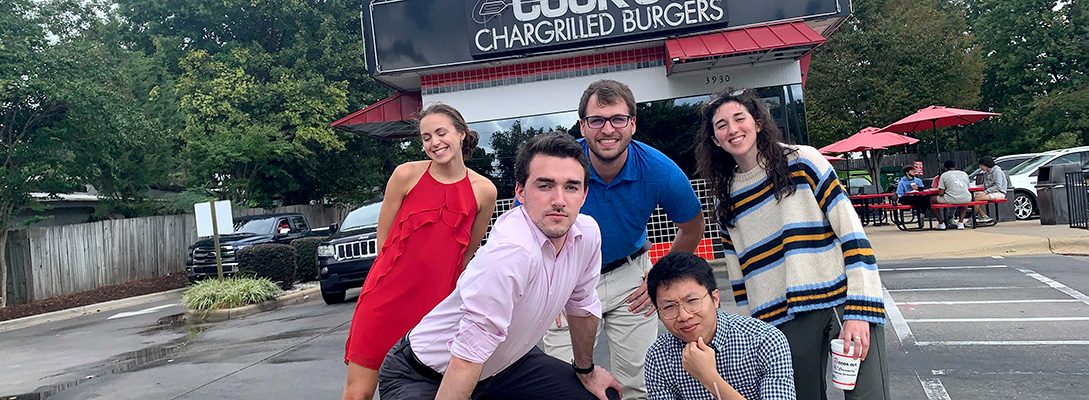School size is often a key factor in a student’s graduate school decision. The small-school vs. large-school debate is seemingly endless. While smaller schools often boast small class sizes and close mentorship from faculty, larger schools tend to extol the benefits of countless academic programs, myriad campus organizations, and the opportunity to be part of something bigger… much bigger.
When I was weighing my undergraduate college options, I decided to attend Wheaton College, a small liberal arts college in Massachusetts. At the time, it only had 1,600 students, and there were only five other students in my major (Chemistry). I loved my undergraduate experience, and I thrived within the college’s tight-knit community. However, by the time I was applying to graduate schools, I was ready to take the leap and attend a larger institution. I was a big fish, and I had outgrown my pond.
Since then, I have attended UNC—Chapel Hill and NC State University. Both are much larger than Wheaton; UNC has a total enrollment of ~30,000, and NC State’s enrollment is ~36,000. The transition from a very small college to two city-like universities was overwhelming, but I found many strategies for making these large universities feel smaller:
- Find your community.
Any university can be made to feel smaller if you find the right people. Here at the Institute for Advanced Analytics (IAA), the Master of Science in Analytics (MSA) students form a community of approximately 100 aspiring data scientists. Attending campus events and exploring Raleigh become much less intimidating when you can go with others. We all share a common interest in analytics, and that common ground creates a safe space for us to share our other passions as well.
- Embrace the sports culture.
Even if you are not interested in sports, I highly recommend attending some games with other members of your graduate program. There is something magical about being in a stadium with hundreds or thousands of people all dressed in the same colors. The energy at these events is unreal, and taking part in athletic traditions can help build a strong sense of belonging. This year’s MSA class regularly attends football games together, and we’re looking forward to basketball season! We have even incorporated NC State’s athletics culture into our academics, as we are involved in an ongoing analytics project with the Women’s Tennis team.
- Take advantage of resources.
One of my favorite things about attending a large university is the availability of resources. Here at NC State, we have extensive libraries, access to journals, guest speakers, and more. One of the main resources we have at the IAA is the Analytics in Practice lecture series. Each week, representatives from companies visit the institute to talk about how they use analytics in their daily work. These sessions are great opportunities to network with other data analytics professionals!
- Get ready to walk… a lot.
If you decide to attend a graduate program at a large university, your days of walking across your entire campus in under ten minutes are over. NC State is the largest university in North Carolina and covers over 2,000 acres of land. The IAA is located on Centennial Campus and is approximately one mile from the main student center, Talley Student Union. While I enjoy the 15-minute walk in the warm North Carolina weather, there is also a bus that travels between Centennial Campus and Main Campus multiple times per day. Even though it takes a while to get around campus, NC State has so much to explore!
- Get involved!
The best way to embrace life at a university like NC State is to get involved with the groups and events on campus or in the greater Raleigh community. There are endless opportunities to pursue hobbies and try new things!
For example, many MSA students play on an intramural soccer team, and there are multiple adult sports leagues throughout the Triangle. Rock climbing is also very popular here; NC State has its own rock wall, and there are several rock clubs that foster a strong climbing community. For those more interested in the arts, there are frequent campus arts events, such as a community weaving project hosted by the College of Textiles. The university also hosts dozens of cultural and religious organizations for those who want to connect with others who share a similar background or learn to appreciate an unfamiliar perspective.
It’s said that a goldfish grows to fit the size of its environment. Even though transitioning from a small college of 1,600 students to a university over ten times its size was a big adjustment, it allowed me the space for continued growth and learning.
I truly believe that the IAA presents the best of both worlds: a small community within a giant university family. If like me, you are considering taking the leap from a small college to a large university, one thing is for certain: once you find your people and engage in the campus community, your new home will begin to feel like a small pond as you grow into the big fish that you were meant to be.
Columnist: Ann Marie Brasacchio
